Dec 16, 2025
Dec 16, 2025
Psoriasis is an immune-mediated, noncontagious, genetic disease manifesting in the skin and/or the joints. Psoriasis is a, lifelong skin disease.
Causes of Psoriasis
These are unknown but it is believed to have a genetic component. Most researchers agree that the immune system is somehow mistakenly triggered, which speeds up the growth cycle of skin cells. A normal skin cell matures and falls off the body's surface in 28 to 30 days. But a psoriatic skin cell takes only three to four days to mature and move to the surface. Instead of falling off, the cells pile up and form the lesions.
Risk factors to trigger Psoriasis
Types of Psoriasis
There are five types of psoriasis.
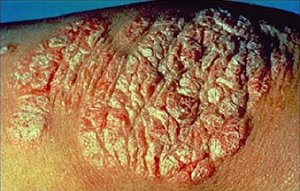 Plaque Psoriasis:
Plaque Psoriasis:
The most common type of psoriasis is called plaque psoriasis. It is characterized by raised, inflamed (red) lesions covered with a silvery white scale. The scale is actually a buildup of dead skin cells.
The technical name for plaque psoriasis is psoriasis vulgaris (vulgaris means common). Plaque psoriasis may appear on any skin surface, though the knees, elbows, scalp, and trunk are the most common locations.
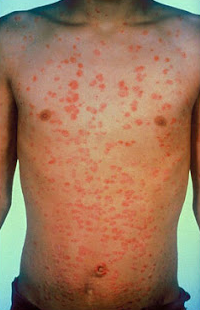 Guttate Psoriasis:
Guttate Psoriasis:
Guttate psoriasis is characterized by small red dots (or drops) of psoriasis. It often appears on the trunk, arms and legs. The lesions may have some scale.
Guttate psoriasis frequently appears suddenly following a streptococcal infection or viral upper respiratory infections.
There are also other events that can precipitate an attack of guttate psoriasis: tonsillitis, a cold, chicken pox, immunizations, physical trauma, psychological stress, illness, and the administration of antimalarial drugs.
Inverse Psoriasis:
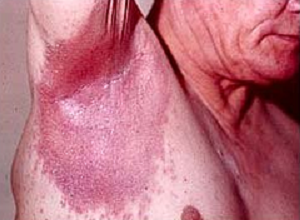 Inverse psoriasis is localized in the flexural surfaces of the skin, e.g., armpit, groin, under the breast, and other skin folds.
Inverse psoriasis is localized in the flexural surfaces of the skin, e.g., armpit, groin, under the breast, and other skin folds.
Typically, it appears as smooth inflamed lesions without scaling and is particularly subject to irritation due to rubbing and sweating.
Erythrodermic Psoriasis:
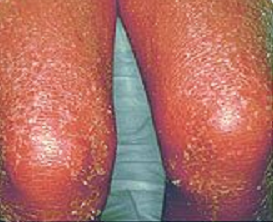
Ordinarily erythrodermic psoriasis appears on the skin as a widespread reddening and exfoliation of fine scales, often accompanied by severe itching and pain. Swelling may also develop.
Pustular Psoriasis:
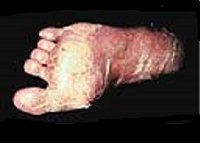 Pustular psoriasis is characterized by pustules (blister-like lesions of noninfectious pus) on the skin. The pus consists of white blood cells in the skin. It is not an infection, and it is not contagious. It may be localized to certain areas of the body, e.g., hands and feet, or it can be widespread. It tends to go in cycles of: 1) erythema (reddening of the skin), 2) formation of pustules, and 3) scaling of the skin.
Pustular psoriasis is characterized by pustules (blister-like lesions of noninfectious pus) on the skin. The pus consists of white blood cells in the skin. It is not an infection, and it is not contagious. It may be localized to certain areas of the body, e.g., hands and feet, or it can be widespread. It tends to go in cycles of: 1) erythema (reddening of the skin), 2) formation of pustules, and 3) scaling of the skin.
Special Conditions of Psoriasis
- Generalized fatigue
- Tenderness, pain and swelling over tendons
- Swollen fingers and toes
- Stiffness, pain, throbbing, swelling and tenderness in one or more joints
- A reduced range of motion
- Morning stiffness and tiredness
- Nail changes; for example, the nail separates from the nail bed and/or becomes pitted and mimics fungus infections
- Redness and pain of the eye, such as conjunctivitis
- The disease can develop in a joint after an injury and may mimic a cartilage tear.
- Muscle or joint pain can occur without joint inflammation.
- Tendonitis and bursitis may be prominent features.
- Swelling of the fingers and toes can suggest a "sausage-like" appearance.
- Psoriatic arthritis affects the distal joints in fingers or toes. The lower back, wrists, knees or ankles also may be affected.
Homoeopathic Treatment for Psoriasis
Homoeopathy is one of the most popular holistic systems of medicine. The selection of remedy is based upon the theory of individualization and symptoms similarity by using holistic approach.
This is the only way through which a state of complete health can be regained by removing all the sign and symptoms from which the patient is suffering. The aim of homoeopathy is not only to treat psoriasis but to address its underlying cause and individual susceptibility. As far as therapeutic medication is concerned; several well-proved remedies are available for psoriasis treatment that can be selected on the basis of cause, location, sensation, modalities and extension of the psoriasis. For individualized remedy selection and treatment, the patient should consult a qualified homoeopathic doctor in person. Few important remedies for the homoeopathic treatment of psoriasis are given below:
Disclaimer: Information provided is for the sole purpose of imparting education on Homoeopathy and is not intended to diagnose, treat, cure or prevent any disease. If you have a medical condition, please consult your physician.
11-Oct-2012
More by : Dr. Navneet Bidani

|
Hai Doctor, I am 65 years and I am suffering fm Psorisiform Plaque n this started since last 4 months. I am taking Imupsora tablet twice a day and applying Zinocort Oilment. Pls adv where I can see a Homepothic Doctor ner my residence at Panvel (Khanda Colony) Tks n Brgds Pillai |

|
I have had psoriasis off and on for about 8 years. During this last year I had my worst outbreak. Both of my elbows were red and cracked. I started putting on DermalMD Psoriasis treatment product and I noticed a big diffrence in a week. I am going on week two and my elbows look great. I can see that the skin is still a little thick but it is not red or noticable. I also have a patch on my knee about 2x3 inches. I have had this for over a year now. It has been so annoying all winter. Before the skin was really red, flakey, and cracked. Now it is pinkish, no flakes, or cracks. It seems to be getting a little better each day. I am really hoping that it totally heals it. Even if it just stays the way it is right now it is worth it. I will update in a month or so and let you know how it is going. |

|
I am 48 years old. I am suffering from psoriasis pluck type on scale elbow and knee and feet for five years. when it triggered it was vigorous on scale , leg and ear. It reduced by treating petroleum 200 and bioplagen 20. But for six months it increasing on feet. My doc. prescribe me kali ars 3x but it is not improving. Pls . suggest me what medicine can I take. Thanks Shameem |

|
i am suffering from psoriasis since 3 yrs , when i started taking kali ars 30 after 3 months it disappered 85 % , but after few days again problem starts , i mostly have problem in hairs as dandruff, nails, & backside of ears , and at at the back ( near to anal area ) , skin folds mostly. what to do ? continue kalii ars or not.. |

|
ACNE ECZEMA IMPETIGO SCABIES PSORIASIS INVETERATA LEPROSY_AC CARBO ACNE ROSACEAE RINGWORM PSORIASIS_AC CHRYSO PSORIASIS ALOPECIA AND THE NAILS BECOME SOFT_AC FLOUR SQUAMOUS ERUPTION ON BODY PSORIASIS GUTTATA_AC FLOUR PARCHED PSORIASIS OF TONGUE_AC MUR PSORIASIS REMOVERS THE DISTRESSING SKIN SYM NITRO_AC MUR SKIN SYMPTOM RESEMBLING PSORIASIS_AC NITRO MUR APATHY IRRESOLUTION AND PSORIASIS AFTER SEPARATING FROM HIS GIRL FRIEND_AC PHOS PSORIASIS LEPRA VULGARIS_AMMO CARB PSORIASIS AND HERPES ZOSTER WORSE LEFT ARM AND CHEST_ANANTHER MUR PSORIASIS OF THE SCALP AND HAIR_ARANEA IX ARTHRITIS AFTER SUPPRESSED PSORIASIS_ARS ALB ECZEMA OF THE SQUAMOUS TYPE PSORIASIS_ARS ALB PSORIASIS ECZEMA SCRATCH UNTIL IT BLEED_ARS ALB PSORIASIS GUTTATA_ARS ALB SKIN IS THICKENED SUCH AS IN CHRONIC ECZEMA PSORIASIS_ARS ALB DRY SCALY BURNING AND ITCHING ERUPTION AS PSORIASIS TINEA IMPETIGO_ARS IOD PSORIASIS AND IN ICHTHYOSIS_ARS IOD PSORIASIS CHILD HEAD COVERED WITH INFLAMMATORY SCALY ERUPTION_ARS IOD PSORIASIS TINEA IMPETIGO_ARS IOD PSORIASIS AND ALSO OF ECZEMA ACNE AND FURUNCLE_ARS S R PSORIASIS_ASTERIAS R PSORIASIS_AURUM M N |

|
I am suffering from psoriasis. I have taken Arsenic album -200 thrice times for two weeks and sulphur-200 thrice a day for one week. But not found more results. kindly adise me for some other medicine with dose |

|
Dr Navneet, Can i get dr. Rekha Chahal from panipat email id if she is the one who worked at samalkha hospital as homeopathy. Looking for her guidance, consultation for my mom and brother. Thanks Sachin |

|
gudmrng doctor shab .very nice article.i want to kmw more abt this.plz send me more article on my e mail i.d.i wil be thankful to you. Regards Dr.Rekha chahal panipat |

|
Even medorrihnum acts very well in cases of genetic origin . |

|
I had psoriasis quite badly,along with the psoratic arthritis for about 2 years . I followed rigorously the advice & elimination diet in The Yeast Syndrome by John Parks Trowbridge M.D & Morton Walker D.P.M for about 6 months, keeping away from bread & sugar ever since. The psoriasis disappeared & has never returned since. That was over 20 years ago. Good luck. |

|
very nice sharing of information, thanks regards |